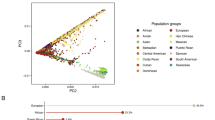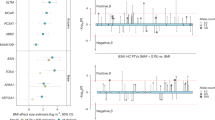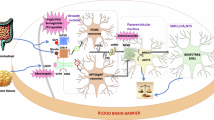Abstract
Obesity is a major public health problem characterized with high body mass index (BMI). Copy number variations (CNVs) have been identified to be associated with complex human diseases. The effect of CNVs on obesity is unknown. In this study, we explored the association of CNVs with BMI in 597 Chinese Han subjects using Affymetrix GeneChip Human Mapping 500K Array Set. We found that one CNV at 10q11.22 (from 46.36 Mb to 46.56 Mb) was associated with BMI (the raw P=0.011). The CNV contributed 1.6% of BMI variation, and it covered one important obesity gene—pancreatic polypeptide receptor 1(PPYR1). It was reported that PPYR1 was a key regulator of energy homeostasis. Our findings suggested that CNV might be potentially important for the BMI variation. In addition, our study suggested that CNV might be used as a genetic marker to locate genes associated with BMI in Chinese population.
Similar content being viewed by others
Log in or create a free account to read this content
Gain free access to this article, as well as selected content from this journal and more on nature.com
or
References
Mascie-Taylor, G. & Goto, R. Human variation and body mass index: a review of the universality of BMI cut-offs, gender and urban-rural differences, and secular changes. J. Physiol. Anthropol. 26, 109–112 (2007).
Zhou, B. Predictive values of body mass index and waist circumference for risk factors of certain related diseases in Chinese adults—study on optimal cut-off points of body mass index and waist circumference in Chinese adults. Biomed. Environ. Sci. 15, 83–95 (2002).
Zhou, B. Effect of body mass index on all-cause mortality and incidence of cardiovascular diseases—report for meta-analysis of prospective studies open optimal cut-off points of body mass index in Chinese adults. Biomed. Environ. Sci. 15, 245–252 (2002).
Rosmond, R. Aetiology of obesity: a striving after wind? Obes. Rev. 5, 177–181 (2004).
Ichihara, S. & Yamada, Y. Genetic factors for human obesity. Cell Mol. Life Sci. 65, 1086–1098 (2008).
Bell, C., Walley, A. & Froguel, P. The genetics of human obesity. Nat. Rev. Genet. 6, 221–234 (2005).
Ciullo, M., Nutile, T., Dalmasso, C., Sorice, R., Bellenguez, C., Colonna, V. et al. Identification and replication of a novel obesity locus on chromosome 1q24 in isolated populations of Cilento. Diabetes 57, 783–790 (2008).
Boutin, P., Dina, C., Vasseur, F., Dubois, S., Corset, L., Seron, K. et al. GAD2 on chromosome 10p12 is a candidate gene for human obesity. PLoS. Biol. 1, E68 (2003).
Liu, Y., Liu, X., Wang, L., Dina, C., Yan, H., Liu, J. et al. Genome-wide association scans identified CTNNBL1 as a novel gene for obesity. Hum. Mol. Genet. 17, 1803–1813 (2008).
Sebat, J., Lakshmi, B., Troge, J., Alexander, J., Young, J., Lundin, P. et al. Large-scale copy number polymorphism in the human genome. Science 305, 525–528 (2004).
Conrad, D., Andrews, T., Carter, N., Hurles, M. & Pritchard, J. A high-resolution survey of deletion polymorphism in the human genome. Nat. Genet. 38, 75–81 (2006).
Redon, R., Ishikawa, S., Fitch, K., Feuk, L., Perry, G., Andrews, T. et al. Global variation in copy number in the human genome. Nature 444, 444–454 (2006).
Marshall, C., Noor, A., Vincent, J., Lionel, A., Feuk, L., Skaug, J. et al. Structural variation of chromosomes in autism spectrum disorder. Am. J. Hum. Genet. 82, 477–488 (2008).
Madrigal, I., Rodriguez-Revenga, L., Armengol, L., Gonzalez, E., Rodriguez, B., Badenas, C. et al. X-chromosome tiling path array detection of copy number variants in patients with chromosome X-linked mental retardation. BMC. Genomics 8, 443 (2007).
Woo, J., Sun, G., Haverbusch, M., Indugula, S., Martin, L., Broderick, J. et al. Quality assessment of buccal versus blood genomic DNA using the Affymetrix 500K GeneChip. BMC. Genet. 8, 79 (2007).
Hua, J., Craig, D., Brun, M., Webster, J., Zismann, V., Tembe, W. et al. SNiPer-HD: improved genotype calling accuracy by an expectation-maximization algorithm for high-density SNP arrays. Bioinformatics 23, 57–63 (2007).
Di, X., Matsuzaki, H., Webster, T., Hubbell, E., Liu, G., Dong, S. et al. Dynamic model based algorithms for screening and genotyping over 100K SNPs on oligonucleotide microarrays. Bioinformatics 21, 1958–1963 (2005).
Rabbee, N. & Speed, T. A genotype calling algorithm for affymetrix SNP arrays. Bioinformatics 22, 7–12 (2006).
Pritchard, J., Stephens, M. & Donnelly, P. Inference of population structure using multilocus genotype data. Genetics 155, 945–959 (2000).
Devlin, B. & Roeder, K. Genomic control for association studies. Biometrics 55, 997–1004 (1999).
de Smith, A., Tsalenko, A., Sampas, N., Scheffer, A., Yamada, N., Tsang, P. et al. Array CGH analysis of copy number variation identifies 1284 new genes variant in healthy white males: implications for association studies of complex diseases. Hum. Mol. Genet. 16, 2783–2794 (2007).
Wong, K., deLeeuw, R., Dosanjh, N., Kimm, L., Cheng, Z. et al. A comprehensive analysis of common copy-number variations in the human genome. Am. J Hum. Genet. 80, 91–104 (2007).
Pinto, D., Marshall, C., Feuk, L. & Scherer, S. Copy-number variation in control population cohorts. Hum. Mol. Genet. 16, R168–R173 (2007).
Jakobsson, M., Scholz, S., Scheet, P., Gibbs, J., VanLiere, J., Fung, H. et al. Genotype, haplotype and copy-number variation in worldwide human populations. Nature 451, 998–1003 (2008).
Sainsbury, A., Schwarzer, C., Couzens, M., Jenkins, A., Oakes, S., Ormandy, C. et al. Y4 receptor knockout rescues fertility in ob/ob mice. Genes Dev. 16, 1077–1088 (2002).
Kamiji, M. & Inui, A. Neuropeptide y receptor selective ligands in the treatment of obesity. Endocr. Rev. 28, 664–684 (2007).
Berglund, M., Hipskind, P. & Gehlert, D. Recent developments in our understanding of the physiological role of PP-fold peptide receptor subtypes. Exp. Biol. Med. (Maywood.) 228, 217–244 (2003).
Batterham, R., Le Roux, C., Cohen, M., Park, A., Ellis, S., Patterson, M. et al. Pancreatic polypeptide reduces appetite and food intake in humans. J. Clin. Endocrinol. Metab. 88, 3989–3992 (2003).
Schmidt, P., Naslund, E., Gryback, P., Jacobsson, H., Holst, J., Hilsted, L. et al. A role for pancreatic polypeptide in the regulation of gastric emptying and short-term metabolic control. J. Clin. Endocrinol. Metab. 90, 5241–5246 (2005).
Beckmann, J., Estivill, X. & Antonarakis, S. Copy number variants and genetic traits: closer to the resolution of phenotypic to genotypic variability. Nat. Rev. Genet. 8, 639–646 (2007).
Parker, E., Van, H. & Stamford, A. Neuropeptide Y receptors as targets for anti-obesity drug development: perspective and current status. Eur. J. Pharmacol. 440, 173–187 (2002).
Lin, E., Sainsbury, A., Lee, N., Boey, D., Couzens, M., Enriquez, R. et al. Combined deletion of Y1, Y2, and Y4 receptors prevents hypothalamic neuropeptide Y overexpression-induced hyperinsulinemia despite persistence of hyperphagia and obesity. Endocrinology 147, 5094–5101 (2006).
Darby, K., Eyre, H., Lapsys, N., Copeland, N., Gilbert, D., Couzens, M. et al. Assignment of the Y4 receptor gene (PPYR1) to human chromosome 10q11.2 and mouse chromosome 14. Genomics 46, 513–515 (1997).
Acknowledgements
We thank all the participants for taking part in this research. Investigators of this project were funded in part by grants from the National Natural Science Foundation of China (30230210, 30771222, 30731160618), Xi’an Jiaotong University and the Ministry of Education of China, Huo Ying Dong Education Foundation, Hunan Province and Hunan Normal University. HWD was supported by Dickson/Missouri endowment from University of Missouri—Kansas City and by grants from NIH (R01 AR050496, R21 AG027110, R01 AG026564, P50 AR055081 and R21 AA015973). We declare that we have no conflict of interest. The genome-wide genotype data will be deposited online soon to be freely available for non-commercial use.
Author information
Authors and Affiliations
Corresponding author
Rights and permissions
About this article
Cite this article
Sha, BY., Yang, TL., Zhao, LJ. et al. Genome-wide association study suggested copy number variation may be associated with body mass index in the Chinese population. J Hum Genet 54, 199–202 (2009). https://doi.org/10.1038/jhg.2009.10
Received:
Revised:
Accepted:
Published:
Issue date:
DOI: https://doi.org/10.1038/jhg.2009.10
Keywords
This article is cited by
-
Obesity and genomics: role of technology in unraveling the complex genetic architecture of obesity
Human Genetics (2015)
-
Etiology of Obesity Over the Life Span: Ecological and Genetic Highlights from Asian Countries
Current Obesity Reports (2014)
-
Low copy number of the salivary amylase gene predisposes to obesity
Nature Genetics (2014)
-
Identification of both copy number variation-type and constant-type core elements in a large segmental duplication region of the mouse genome
BMC Genomics (2013)
-
Multiphasic analysis of whole exome sequencing data identifies a novel mutation of ACTG1 in a nonsyndromic hearing loss family
BMC Genomics (2013)



